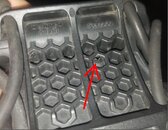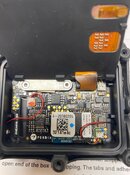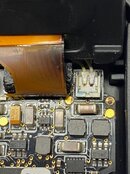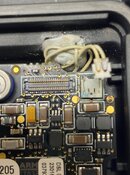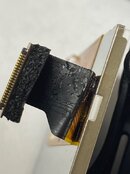Should warm up by then....I don't have anything tech-ish planned for at least another few months.
You are using an out of date browser. It may not display this or other websites correctly.
You should upgrade or use an alternative browser.
You should upgrade or use an alternative browser.
Shearwater Perdix AI Random Dives Caused from Freezing???
- Thread starter rob.mwpropane
- Start date
Please register or login
Welcome to ScubaBoard, the world's largest scuba diving community. Registration is not required to read the forums, but we encourage you to join. Joining has its benefits and enables you to participate in the discussions.
Benefits of registering include
- Ability to post and comment on topics and discussions.
- A Free photo gallery to share your dive photos with the world.
- You can make this box go away
So I was thinking some more last night. Checked my dc and no new dives. I am guessing the small hole on the back is where the pressure sensor gets its reading from?
I went through how I put stuff away in my head. I (for whatever reason) always place my dc upside down in the case (I guess to save the face), but I leave it 1/2 unzipped to air out if it's wet. So I really think it's ice (THANKS @-JD- !!!). It sits there upside down in the case in my bag and when it freezes causes the pressure sensor to think there's a dive. I wish @ShearwaterJay (that's the only name I could find to Shearwater?) would maybe comment if they've seen this before?
Anyway, I think I'm clear. Pretty interesting, I know lots of people that ice dive but I've never hear of this before.
If Shearwater does email me back I'll post my findings here. At some point I still need to send it in for service, but thankfully I don't think there's any "extra" charges.
I went through how I put stuff away in my head. I (for whatever reason) always place my dc upside down in the case (I guess to save the face), but I leave it 1/2 unzipped to air out if it's wet. So I really think it's ice (THANKS @-JD- !!!). It sits there upside down in the case in my bag and when it freezes causes the pressure sensor to think there's a dive. I wish @ShearwaterJay (that's the only name I could find to Shearwater?) would maybe comment if they've seen this before?
Anyway, I think I'm clear. Pretty interesting, I know lots of people that ice dive but I've never hear of this before.
If Shearwater does email me back I'll post my findings here. At some point I still need to send it in for service, but thankfully I don't think there's any "extra" charges.
Attachments
If that is the port, I could see it taking a really long time to dry out, especially in cold and/or humid conditions, as there is probably minimal airflow in a half-unzipped bag in an enclosed space, much-less through a tiny port hole in the DC itself. Even if it was left port-down, surface tension might be stronger than gravity and keep a droplet in there.So I was thinking some more last night. Checked my dc and no new dives. I am guessing the small hole on the back is where the pressure sensor gets its reading from?
I went through how I put stuff away in my head. I (for whatever reason) always place my dc upside down in the case (I guess to save the face), but I leave it 1/2 unzipped to air out if it's wet. So I really think it's ice (THANKS @-JD- !!!). It sits there upside down in the case in my bag and when it freezes causes the pressure sensor to think there's a dive. I wish @ShearwaterJay (that's the only name I could find to Shearwater?) would maybe comment if they've seen this before?
Anyway, I think I'm clear. Pretty interesting, I know lots of people that ice dive but I've never hear of this before.
If Shearwater does email me back I'll post my findings here. At some point I still need to send it in for service, but thankfully I don't think there's any "extra" charges.
Anybody got a dead Perdix and want to do a dissection on it in the name of SB science?!
Or, drop a query to DiveTronix.Anybody got a dead Perdix and want to do a dissection on it in the name of SB science?!
Looking at the specs in the manual, the sensor/DC is rated for 260M .
None of the phantom dives that you showed exceeded 50M. My gut is that the sensor is probably OK since you were around 1/5th of the max pressure AND it seems to have performed properly after.
There may be a degree of self-limiting: since the hole is open, as the water begins to crystalize into ice there should be some ability for it to escape into/through/out of the hole. a cross section of the sensor chamber would be interesting.
The sensors that I have seen have the piezo element "glued" to a metal diaphragm. If that bond is broken they are done-for.
None of the phantom dives that you showed exceeded 50M. My gut is that the sensor is probably OK since you were around 1/5th of the max pressure AND it seems to have performed properly after.
There may be a degree of self-limiting: since the hole is open, as the water begins to crystalize into ice there should be some ability for it to escape into/through/out of the hole. a cross section of the sensor chamber would be interesting.
The sensors that I have seen have the piezo element "glued" to a metal diaphragm. If that bond is broken they are done-for.
I agree.If that is the port, I could see it taking a really long time to dry out, especially in cold and/or humid conditions, as there is probably minimal airflow in a half-unzipped bag in an enclosed space, much-less through a tiny port hole in the DC itself. Even if it was left port-down, surface tension might be stronger than gravity and keep a droplet in there.
Pictures attached might help (I don't remember where I got them, but not mine). I don't have an issue opening up computers and cleaning / fixing stuff, but I have no idea what I'm looking at on a little board like this. The two screws holding the bar down would tell me that hole is the pressure sensor.Anybody got a dead Perdix and want to do a dissection on it in the name of SB science?!
If I had the right seals / gaskets and the right torque spec I might even be tempted to "re-seal" it myself.
Not sure they would be all that helpful in telling people how to take work away from them?Or, drop a query to DiveTronix.
Attachments
I was only thinking to ask if the pressure port is that little hole.Not sure they would be all that helpful in telling people how to take work away from them?
Maybe start bringing the electronic inside when it’s that cold outside.
That was the deepest dive.Looking at the specs in the manual, the sensor/DC is rated for 260M .
None of the phantom dives that you showed exceeded 50M.
There may be a degree of self-limiting: since the hole is open, as the water begins to crystalize into ice there should be some ability for it to escape into/through/out of the hole. a cross section of the sensor chamber would be interesting.
The sensors that I have seen have the piezo element "glued" to a metal diaphragm. If that bond is broken they are done-for.
That's at the top of my list!Maybe start bringing the electronic inside when it’s that cold outside.
From Richard @ Divetronix (seems like a great guy);Or, drop a query to DiveTronix.
"The depth sensor is located on the backside of the circuit board. If you turn your computer to the honeycomb side, you will see a round hole on the upper right side, under the honeycomb. That hole allows water to reach the depth sensor to register pressure/depth and temperature."
So that would be it.
Similar threads
- Replies
- 13
- Views
- 514
- Replies
- 26
- Views
- 1,967
- Replies
- 10
- Views
- 1,633




